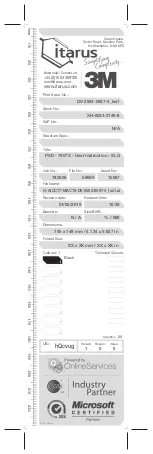
SURVIVAIR Opti-Fit
™
Convertible Facepiece
28
Figure 27b. Properly Fitted Headnet
5. Fit Check Instructions for PAPR Configurations
You must perform the following fit check each time
the respirator is worn or before entering the con-
taminated area.
WARNING
If a leak-tight seal is not obtained during
the following fit check, do not wear the
respirator. Ask your supervisor or safety
professional for assistance. The failure
to comply with this warning may lead to
personal injury, illness, or death.
1. Turn off the blower
For mask-mounted setup:
Remove the filter from
the blower.
For belt-mounted setup:
Remove the breathing
tube from the facepiece nozzle.
2. Cover the blower inlet with your hand and inhale
gently, slightly collapsing the facepiece.
3. Hold your breath for approximately 5 seconds.
The facepiece should remain slightly collapsed.
If it does not, readjust the facepiece and perform
the fit check again. If a seal is still not achieved,
do not wear the respirator. Ask your supervisor
or safety professional for assistance.
4. If a good fit was achieved:
For mask-mounted setup:
Reattach the filter
onto the blower assembly and press the ON/OFF
switch on the battery pack to start the blower.
For belt-mounted setup:
●
Attach the breathing tube to the facepiece noz-
zle: Push the facepiece connector end of the
breathing tube onto the nozzle of the facepiece.
Align the catch on the connector with the slot
in the nozzle. Push the connector until the latch
completely engages with the nozzle.
●
Screw the breathing tube into the blower outlet
and tighten securely.
●
Press the ON/OFF switch on the battery pack to
start the blower.
NOTE
In the event of a decrease or loss of airflow
from the blower for both the mask-mounted
and belt-mounted PAPR configurations, the
wearer can safely breathe through the blow-
er/filter assembly until reaching an uncon
-
taminated area.
WARNING
Verify that the blower is providing air to
the facepiece before entering a hazard
-
ous environment. You should feel air
blowing onto your face. Improper air-
flow may result in inhalation of contam
-
inants. The failure to comply with this
warning may lead to personal injury, ill-
ness, or death.
6. How to Use the Respirator
Before entering the work area for the first time or re-
entering for any reason, you must verify proper op-
eration of the respirator in accordance with the Pre-
operational Flow Check procedure of Section VIII,
Part C.3, and also follow the donning procedures
described in Section VIII, Part C.4.
To receive the maximum protection available from
your respirator, you must read, understand, and
follow all the warnings, limitations, and instructions
contained in this manual and follow your employer’s
instructions on the use and maintenance of the res-
pirator. Read and understand the following warnings
prior to using the respirator.
WARNING
● The respirator consists of a full face
-
piece constructed of silicone with
a polycarbonate lens, blower, filter,
battery, power cord, and a belt. It is
the user’s responsibility to verify
that the respirator materials are ac-
ceptable for their intended use. If
you are unsure, consult you local
safety professional to verify that no
possible contaminants and/or liq-
uids will permeate through any of
the respirator materials.
● Do not don, doff, or store the respi
-
rator in an area where contaminants
can contact or accumulate inside
any component of the respirator.
Contaminants inside the facepiece
may be inhaled or absorbed upon
reuse of the respirator.
● Never remove the respirator for any
reason while in the work area.










































